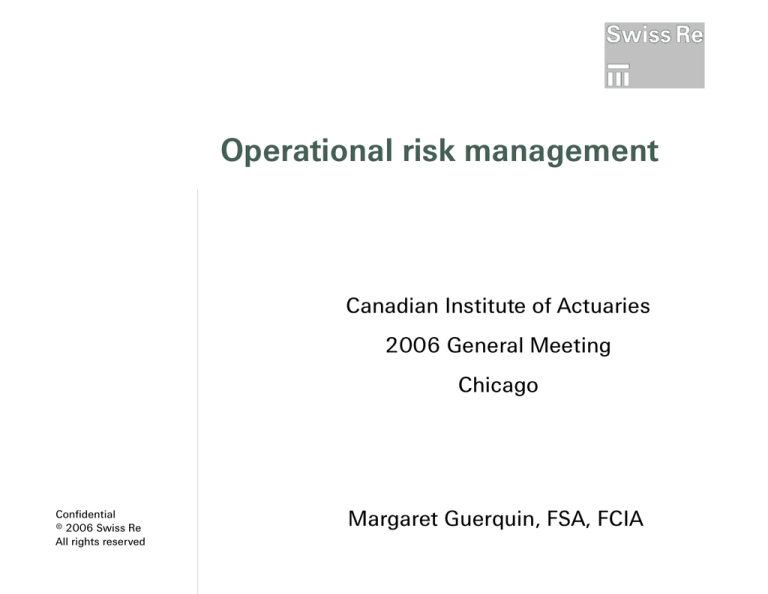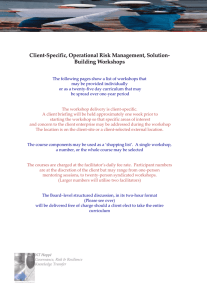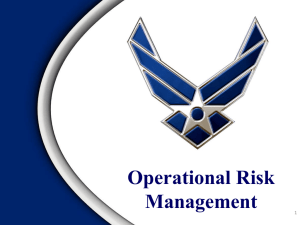
Operational risk management
Canadian Institute of Actuaries
2006 General Meeting
Chicago
Confidential
© 2006 Swiss Re
All rights reserved
Margaret Guerquin, FSA, FCIA
Contents
Enterprise risk management (ERM)
Operational risk management (ORM)
– Risk and control self assessment
– Key risk indicators
– Loss-event database
– Audits
– Sarbaines-Oxley Act (SOX)
– ORM awareness
Confidential
© 2006 Swiss Re
All rights reserved
Slide 2
Conclusion
Enterprise risk management
Confidential
© 2006 Swiss Re
All rights reserved
Slide 3
Significant increase in risks faced by people and
organizations
Corporate governance and disclosure rules, along with
the independent board of directors rapidly gaining
importance among companies
Increasing pressure from rating agencies to establish a
strong risk management focus in the company
ERM vital element in most corporations.
ORM important part of ERM
Operational Risk Management
Operational risk:
– Expected and unexpected economic impact of
inadequate or failed internal processes, people,
system or external events
– Should be minimized
– Affects other risks
Confidential
© 2006 Swiss Re
All rights reserved
Slide 4
Operational risk management
ORM role:
– Ensure operational risks identified and effectively and
efficiently managed
– Reduce risk to predefined limits in cost-effective
manner
– Ensure legal requirements and internally set limits
are followed
Confidential
© 2006 Swiss Re
All rights reserved
Slide 5
Operational risk management
The ORM structure:
– Clearly defined
– Clearly identifies roles and responsibilities
– Risk owners
– Risk takers
– Risk controllers
Confidential
© 2006 Swiss Re
All rights reserved
Slide 6
Operational risk management
Five key steps of ORM process:
– Identification and classification
– Assessment, measurement and mitigation
– Monitoring and assurance
– Reporting
– Steering decisions
Confidential
© 2006 Swiss Re
All rights reserved
Slide 7
Operational risk management
Elements supporting ORM
– Risk and control self assessment
– Key risk indicators
– Loss-event database
– Audits
– SOX
– ORM awareness
Confidential
© 2006 Swiss Re
All rights reserved
Slide 8
ORM: Risk and control self assessment
Risk and control self assessment (RCSA) as
management tool to
– Identify
– Assess
– Measure
– Mitigate
Confidential
© 2006 Swiss Re
All rights reserved
Slide 9
Organization’s needs determine level of detail
Several RCSA systems currently available
ORM: Risk and control self assessment
Identification and classification of operational risks
– Identify events that could have a significant
negative financial or reputational impact on the
company
– Basel II four risk categories:
– Process
– People
– System
– External events
Confidential
© 2006 Swiss Re
All rights reserved
Slide 10
– Usefulness of common definitions and descriptions
of risks and risk categories
ORM: Risk and control self assessment
– Identification of controls
– Key objective: reduce operational risk exposure
to acceptable level
– Preventive and detective controls
– Recommend no more than six to eight controls
per risk
– Possible mitigation of more than one risk by the
same control
Confidential
© 2006 Swiss Re
All rights reserved
Slide 11
ORM: Risk and control self assessment
Assessment
– Operational risk exposure
– Severity: most likely monetary loss in the
absence of any internal controls
– Frequency: how often an event of at least the
size of severity is expected to occur in the
absence of any internal controls
– Inherent risk: risk measure in the absence of
internal controls
– Residual risk: remaining level of risk after
controls in place.
Confidential
© 2006 Swiss Re
All rights reserved
Slide 12
ORM: Risk and control self assessment
– Inherent risk value
– Identify significant potential loss exposure
– Identify areas requiring mitigation activities
– Residual risk value
– Identify inadequate control
– Focus of remediation activities
– Areas with residual risk value outside acceptable
limits.
Confidential
© 2006 Swiss Re
All rights reserved
Slide 13
ORM: Risk and control self assessment
– Control assessment
– Control design effectiveness
– Level of risk mitigation
– Rated: very high, high, medium and low
– Control operating effectiveness
– Operational control quality in practice
– Rated: fully effective (“green”), partially
effective (“amber”), or not effective (“red”)
– Effective, well-designed controls
Confidential
© 2006 Swiss Re
All rights reserved
Slide 14
– Reduce the expected loss
– Reduce the standard deviation of that loss
ORM: Risk and control self assessment
Measurement
– Failure rates of control design and control operating
effectiveness together with severity and frequency
of inherent risk
– Allow to calculate expected annual loss amounts
for every residual risk
– Basis for calculating required capital for
operational risk
Confidential
© 2006 Swiss Re
All rights reserved
Slide 15
ORM: Risk and control self assessment
Mitigation
– Compare expected losses with a predefined risk
acceptance limit
– Raise an issue and/or an action plan
– Take an appropriate mitigation steps
Confidential
© 2006 Swiss Re
All rights reserved
Slide 16
ORM: Key risk indicators
Key risk indicators (KRI)
– Measures that provide information about
organization or levels of activity indicating
potential or actual changes in risk exposure
– One of the basic elements of an effective ORM
– Identify areas requiring management attention
and/or action
– Monitor changes in risk profile and controls
performance
– Require meaningful benchmark and margins
Confidential
© 2006 Swiss Re
All rights reserved
Slide 17
ORM: Loss-event database
Loss event database
– Loss event: occurrence that leads to a financial
cost, lost benefit or both.
– A loss event database
– Captures losses and incidents
– Serves as
– Learning tool
– Input to risk quantification
Confidential
© 2006 Swiss Re
All rights reserved
Slide 18
ORM: Audits
Audits
– Crucial function of ORM
– Through audits, operational processes can be
checked, issues raised and corrective action
determined.
– Internal or external audits
– Good control of company operations by thoughtful
audit coverage planning and execution
– Significant help in managing risks through
reporting audits’ activities, substandard results,
and follow up on an audits’ open issues
Confidential
© 2006 Swiss Re
All rights reserved
Slide 19
ORM: Sarbanes-Oxley Act
Sarbanes-Oxley Act (SOX)
– Introduced by US Congress in 2002 after major US
corporate scandals.
– Compliance with Act by all publicly-traded
companies in US
– One of primary goals to help restore investor
confidence.
– SOX important part of operational risk management
process.
– Compliance with SOX enhances management of
operational risks.
Confidential
© 2006 Swiss Re
All rights reserved
Slide 20
ORM: Sarbanes-Oxley Act
SOX compliance requirement:
– All applicable companies must establish financial
accounting framework that can generate financial
reports readily verifiable with traceable source
data.
– Source data must remain intact and cannot
undergo undocumented revisions.
– Revisions to financial or accounting software must
be fully documented
Confidential
© 2006 Swiss Re
All rights reserved
Slide 21
ORM awareness
ORM awareness
– Essential part of effective risk management.
– Raised throughout company by implementing open
operational risk culture:
– Employees openly report operational risks and
losses
– Active learning from mistakes encouraged
– Active promotion with full support, engagement of
senior management, board of directors
Confidential
© 2006 Swiss Re
All rights reserved
Slide 22
Conclusion
Confidential
© 2006 Swiss Re
All rights reserved
Slide 23
Increased awareness of operational risks triggered by
corporate failures made operational risk management
integral part of every company
Shareholders, regulators, and rating agencies dictate
tight control to minimize related losses
Implementing assurance framework helps utilize best
practices and provides proactive response to avoid
future scandals






